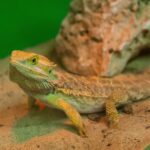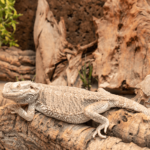Are you the proud owner of a bearded dragon? Are you looking for the perfect way to keep your scaly friend healthy and happy? If so, then it’s time to learn about humidity!
Bearded dragons require an environment with just the right amount of humidity in order to live long and prosperous lives. But how do you get that balance just right? Don’t worry — we have all the answers here in this ultimate guide on humidity for your bearded dragon.
We’ll cover everything from what is ideal humidity levels are, to how to raise or lower them if necessary, as well as why getting it right is so important. So let’s start learning!
When it comes to keeping a bearded dragon as a pet, temperature is often the first thing that new owners think about. After all, everyone knows that reptiles need warmth in order to survive and thrive.
However, what many people fail to realize is that humidity levels are just as important for the health of their reptile friend!
Proper humidity levels can help keep your bearded dragon healthy and comfortable while providing them with an environment similar to their natural habitat in the Australian outback. Getting the right balance between temperature and humidity can be tricky, but with some knowledge and effort you can create a perfect home for your scaly companion.
In their natural habitat, bearded dragons typically have a relative humidity (RH) of 35-40%. This is the typical range for the arid to semi-arid regions of the Australian Outback to which bearded dragons are native.
They love a dry heat!
These native habitats in New South Wales, Queensland, South Australia and Victoria are very dry. There is not much rain or humidity in these regions. They usually have hot temperatures and little vegetation. As a result, bearded dragons are adapted for maximum comfort and optimal health in environments with these conditions.
In captivity, it is important to recreate the natural environment of a bearded dragon as closely as possible. This means providing an enclosure with humidity levels that are between 35-40%.
The relative humidity (RH) of your bearded dragon’s tank should be 35-40%. Relative humidity means the amount of moisture in the air relative to the maximum possible for that temperature. The best way to measure humidity levels is with a hygrometer. This should be calibrated to ensure accuracy, as this will help you maintain the correct levels of humidity in your pet’s enclosure.
You shouldn’t expect the humidity level of your bearded dragon’s tank to automatically register at the ideal 35-40%. You may need to make adjustments in order to achieve this.
Fortunately, there are a few easy methods for raising or lowering the humidity in your pet’s enclosure.
1. Make sure the water bowl is away from any heat sources in the tank, as this can lead to excessive evaporation of water.
2. Equip your tank with a mesh lid, or one that allows for ample ventilation. Solid enclosure tops restrict ventilation and prevent air exchange with the outside environment, resulting in higher humidity levels.
3. Place a dehumidifier in or near the tank, as this can help to absorb moisture from the air and lower the humidity levels.
4. Use a fan to help circulate the air in the room and lower the humidity in your tank.
5. Decrease the amount of natural plants in your beardie’s tank. These can often release moisture into the air, making it more humid.
 Mesh tops allow for greater air circulation and help lower humidity
Mesh tops allow for greater air circulation and help lower humidity
1. Place the water bowl closer to heat sources in the tank, as this will help to evaporate more moisture into the air.
2. Periodically spray the enclosure with a misting bottle. This will add moisture to the air and increase the humidity levels.
3. Increase the amount of natural plants in your pet’s tank, as this will help absorb water throughout the day and release it into the air.
4. Place a humidifier in or near to your tank, as this will help add moisture to the air and increase the humidity levels.

There’s no way to accurately measure the humidity levels in your bearded dragon’s enclosure without a hygrometer. It is important to calibrate the hygrometer before using it, as this will help ensure the accuracy of your readings.
A hygrometer is a digital or analog device that measures the relative humidity (RH) of the surrounding air. Most hygrometers are simple to use and come with instructions on how to calibrate. Once you have the device set up, you can easily monitor the levels of humidity in your pet’s enclosure and make the necessary adjustments to ensure it is always within the correct range.

These models are usually cheaper than digital ones and are easy to use. They also require no batteries, so they can last a very long time with proper maintenance. Mechanical hygrometers indicate the relative humidity of surrounding air with a moving needle.
However, mechanical hygrometers can be more difficult to calibrate and may not give you an accurate reading of the humidity levels in your bearded dragon’s tank.
Additionally, they must be kept inside the tank. Some owners grow frustrated with the bulky size of mechanical hygrometers, as they can take up valuable space in a reptile tank.
These devices, also called probe hygrometers, are more expensive than mechanical models, but they offer the most accurate readings and make it easier to monitor the humidity levels in your bearded dragon’s enclosure.
Digital hygrometers have a probe that can be placed inside the tank, which gives you more precise readings of the humidity levels. They are also easier to calibrate and require less maintenance than mechanical models.
Some owners like that they can simply position the probe in the tank and leave the bulky device outside. This allows them to conserve more space in the bearded dragon’s enclosure.
For the most accurate readings, you should place the hygrometer in the center of your bearded dragon’s tank. This will ensure that you get an accurate measure of the average humidity levels throughout the enclosure.
- Place the device away from direct heat sources, as these can give false readings
- Make sure that the probe of the hygrometer is not covered and can receive an accurate reading
- Position your hygrometer in an area that is not blocked by rocks, logs or other items in the enclosure. Avoid placing next to live plants, as these give off moisture that can throw off readings
- Do not place the hygrometer in a corner of the tank, as this can give false readings
- Clean the hygrometer regularly to ensure dust and particles are not interfering with the device
It is important to maintain the proper humidity levels in your bearded dragon’s tank for its overall health and wellbeing. Levels that are too low or too high can lead not only to stress and discomfort, but also to serious health issues that could be fatal.
If you suspect your pet is suffering from a humidity-related issue, it is important to seek out professional veterinary care as soon as possible and work to correct the humidity levels in its enclosure.
Excess humidity causes many health issues for bearded dragons, including:
- Respiratory infections
- Bacterial growth
- Fungal growth
- Ulcerative or necrotic dermatitis
- Mycotic disease
A lack of humidity can cause health problems also, including:
- Dehydration
- Avascular necrosis
- Renal disease
- Non-obstructive dystocia
All of the diseases listed above can be prevented with proper monitoring of the humidity levels in your bearded dragon’s tank. With the right hygrometer and some careful attention to detail, you can ensure your pet enjoys a healthy and happy life.

Maintaining the right humidity levels in your bearded dragon’s tank is essential for its health and happiness. By using a hygrometer, you can keep track of the humidity levels in your reptile’s enclosure and take steps to correct it when necessary.
Armed with the right tricks for lowering or raising humidity as needed and some tips on the best placement of your hygrometer, you can ensure that your pet enjoys a comfortable and healthy home.





:max_bytes(150000):strip_icc()/13-f9fc54bc64854d20b43e00db91a9cb16.jpg)